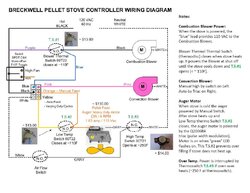Too LARGE...will be 2 Part/Posts
Came across this trolling the internet:
<begin c&p>
Control Board Functions
Product models covered: BrandX AC & DC units
Topic: This technical bulletin will be addressing how the control board operates, what it
initiates, the difference between the AC and the DC board, manual mode, T-stat mode,
diagnostics, voltages, and how the control board and other electrical parts work together to make
the unit operate.
The AC and DC control boards primarily function the same way, except the DC board
has to function on 12 volts of power. It is imperative that the voltage power supply is constant
and the board has the consistent voltage for each operation. If the voltage is not consistent every
time, it will not allow the blowers to operate properly. Throughout this bulletin, information will
be listed pertaining to AC or DC. Each function of the circuit board will be explained to give a
clear picture of how each operation has to work. When appropriate page numbers will be
referred, in the owner’s manual, to avoid duplication of effort. The owner’s manual gives a good
insight on how the board needs to operate. When the power is plugged in to the unit or circuit
board, the board goes through a self diagnostic check, which tests all circuits to make sure that
everything is operating correctly. If any of the safety features are tripped like: low limit sensor
thermostat, high limit sensor thermostat, open circuits or closed circuits that are not supposed to
be, a light will blink in the heat level bar to indicate what is wrong. If the #3 heat setting light
blinks, it means that the proof of fire (low limit 110 deg. Thermostat located on the exhaust
blower) is not operating properly (read page 30 of the owners manual). If the #2 heat setting
light blinks, it means that the vacuum switch has tripped and the circuit is open. Once power is
plugged in and the board has gone through its self diagnostics, the board is ready for operation.
When the ON/OFF button is pushed, it will initiate the startup cycle, (read page 29, circuit board
functions), the draft/exhaust blower starts up (full voltage), and the timed cycle begins.
Startup cycle: When the board’s ON/OFF button is pushed and the draft blower kicks in, a
timed cycle is initiated. The cycle has a minimum time of 8 minutes and a maximum time of 15
minutes. During this time the proof of fire snap disk (110 deg. normally open) has to engage or
the board will go into a shut down cycle. Also, the vacuum sensor circuit must be closed or the
board will go into a shut down cycle (the auger motor will not turn while the switch is open).
The room fan will not run unless the proof of fire snap disk is closed. During the startup cycle
the board automatically will run a startup feed rate, (Room fan voltage AC= line voltage, DC=
12 volts) (Draft blower voltage AC= line voltage, DC= 12 volts). This will be the startup feed
rate for the auger motor no matter what mode that the board is in. This feed rate will run until the
proof of fire snap disk thermostat closes or the board goes past the 15 minute startup cycle and
shuts down. If the proof of fire snap disk closes before the 8 minute minimum startup time, the
feed rate will stay at the start up feed rate until the 8 minute minimum, then it will go to
whatever feed rate has been selected (1-5) The feed rate is selected by pushing the heat level
button once for each heat setting. The heat level button will function 30 seconds after the
ON/OFF button is pushed. The ON/OFF light will blink during the start up cycle until the proof
of fire snap disk is closed, the 8 minute minimum has passed, or the 15 minute total cycle has
passed, then the light will stay lit solid green. After 30 seconds of start up time has passed, the
auger button can be pushed and held to bypass the timed auger cycle and the auger will run
continuous as long as the button is pushed. When the button is released, the auger will go back
to the start up timed cycle. If the board is in the “manual” mode setting, all start up cycle
operations will function. If the board is in the “T-stat” mode the board will go through the start
up functions even if the wall thermostat is not calling for heat. When the 15 minute cycle is
completed the board will go to whatever heat setting the manual or T-stat mode dictates. If the
board is in the “auto” mode, the wall thermostat has to be calling for heat for the start up cycle to
initiate.




